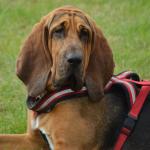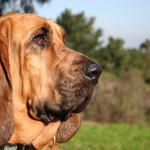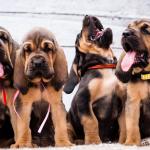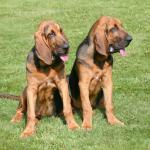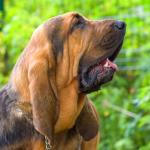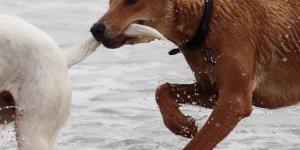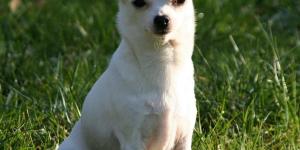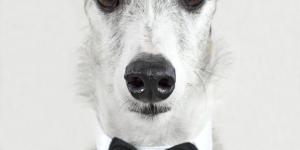Bloodhound (St. Hubert's dog)
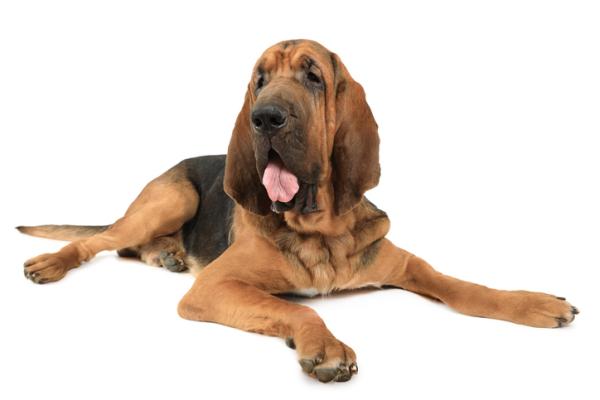
The Bloodhound, also known as St. Hubert's dog, is originally from Belgium. This dog breed is one of the oldest breeds in the world and are known for being very good guardians and companions.
If you're thinking of adopting a Bloodhound, keep reading this AnimalWised breed sheet. We'll go through their origin, characteristics, care and more!
- Europe
- Belgium
- Group VI
- 5-14
- 14-18
- 18-22
- 22-27
- 27-31
- More than 31
- 2-7
- 7-22
- 22-55
- 55-100
- 100-220
- 8-10
- 10-12
- 12-14
- 15-20
- Low
- Meidum
- High
Origin of the bloodhound dog
The Bloodhound was, according to legend, first bred ca. AD 1000 by monks at the Saint-Hubert Monastery in Belgium. These dogs could have remained "isolated" in this region for several years, until King William "the Conqueror" decided to import some specimens to England during the 11th century.
The Bloodhound as we know it today, most likely, is the result of selective crosses between the direct descendants of the St. Hubert dogs imported from Belgium with some individuals of the Bullmastiff breed.
Due to its extraordinary sense of smell, the St. Hubert dog has historically been trained as a detector or tracking dog. Shortly after their creation, the breed was already used in searching and rescuing pilgrims who were lost among the mountains and forests of the Ardennes region. The Bloodhound has also been used for hunting for many years.
In the official standard of the Federation Cynologique Internationale (FCI), the bloodhound is classified in section 1.1 of group 6, which comprises large-sized hound-type dogs.
Physical characteristics of the bloodhound
The Bloodhound is a large dog that stands out for their solid body, slightly longer than it is tall (rectangular profile), with a broad, long and oval chest, strong legs and well-developed muscles. In fact, Bloodhounds are considered the most powerful among all hound-type dogs, according to the official FCI standard.
Females can measure between 58 and 63 cm at the withers, while males are between 63 and 69 cm. The ideal body weight of the breed is around 41 and 50 kg, considering the dimensions of each individual. Despite its size and robustness, the Bloodhound should not be fat or coarse, showing harmonious lines and being able to execute precise and agile movements.
One of the most striking features of the bloodhound is the thin and hanging skin that is observed in their neck and head region, forming abundant wrinkles and folds. Their head, which shows a square profile with a shallow stop, may be somewhat similar to that of the basset hound, but the Bloodhound's head is noticeably larger. Their muzzle is wide and should be as long as the dog's skull, maintaining a uniform width throughout its length.
Their thin and flexible ears are also very striking, both for their large size and for the velvety texture they reveal to the touch. Its insertion is very low, being able to begin at the level of the eyes or even lower, and extending almost to the base of the neck. Eventually, the Bloodhound's eyes can give it a somewhat “sad” look because of their distended lower eye lids, leaving part of its conjunctiva exposed. However, sunken eyes and eyelids that are too distended are not desirable, as they can harm the animal's health.
The bloodhound's coat is made up of short, hard, straight hair. Their hair on their ears and head are softer to the touch and rougher and longer on their tail. Regarding the color of the coat, three variations are accepted: solid red (or unicolor), the bicolor black and tan, and the bicolor fire and liver. Although not a desirable feature, white hair is tolerated on the fingers, the tip of the tail, and the front of the thorax.
Character of the bloodhound or St. Hubert's dog
Bloodhounds are very large and active dogs, however when it comes to their personality they are actually very friendly, docile and quite calm. They have a special bond with their human companions with whom they are extremely loyal to.
This breed is very friendly, however they are not always gentle and patient with children. That's why they're not the best breed for a family with young children. These dogs also need a lot of companionship as they can suffer from loneliness when left alone for a couple of hours. This will lead them to develop behavioral problems and suffer from separation anxiety.
How to care for a Bloodhound
Due to their large size, Bloodhounds will need a lot of space to run freely and explore. This dog breed isn't ideal for small homes, but thrive in large houses with back yards and more so in a farm with lots of land to enjoy. In other words, a Bloodhound will need lots of space and exercise.
Other than their active lifestyle, a Bloodhound will also need their companion to care for their coat. Brushing their coat once per week is more than enough to remove dead hairs and keep their coat clean. When it comes to bathing them, you can bathe them once every two or three months. You will also need to clean any skin fold or wrinkles to avoid the concentration of moisture or bacteria, as this leads to infections.
Nutrition will also be very important when caring for a Bloodhound. Make sure to feed your dog a natural and balanced canine diet, full of healthy protein and fats. This will help your dog have a high quality of life. You will also need to clean their teeth to avoid any dental diseases. Other than that, keep up with your dog's vaccination and deworming schedule. By doing all of this, you ensure yourself that your dog will live a happy and healthy life.
Training your Bloodhound
You should begin training your Bloodhound when they are a puppy. This way, we help them have a balanced temperament as adults. A puppy's training begins with proper socialization and paper training. By socializing our puppy and introducing them to other dogs, humans and new places, we're helping them get used to new situations and environments. This is what will help them be a well-behaved and calm dog as an adult.
Teaching them to relieve themselves in a certain area, such as in paper training, will not only be useful for you as it makes cleaning up after them easier, but it will also help your dog recognize when they need to go urinate and be able to control their bladder.
Once your dog has started getting all the necessary vaccinations, you can start socializing them outside. This is when they can learn to relieve themselves outside when they're on their daily walks. This is also when you can begin teaching them basic commands that will also help you keep them safe in certain situations.
Lastly, once your Bloodhound is an adult, you'll need to continue training them through positive reinforcement. This way, training will not only be a fun activity that will entertain your dog and challenge their cognitive skills, but will also be a time to bond with you, their companion. Remember that dogs are very sensitive animals, therefore, if they misbehave, a simple firm “no” is suffice. There is no reason for verbal or physical violence. It will only cause your relationship with them to suffer and it may also cause behavioral issues in your dog.
Health care
Like all canine breeds, Bloodhounds may have a certain genetic predisposition to develop some hereditary and degenerative diseases. The most common conditions in these dogs are usually hip dysplasia and stomach torsion. The Bloodhound is also prone to the following health issues:
- Elbow dysplasia
- Dry eye (Keratoconjunctivitis sicca in dogs)
- Prolapse of the third eyelid
- Entropion
- Ectropion
- Pyoderma
- Obesity
When it comes to health care, we must remember to keep up with our dog's vaccination and deworming schedule, as well as take out dog for regular check ups. With this being said, the life expectancy of Bloodhounds is between 10 and 12 years.
Bloodhound (St. Hubert's dog) photos

